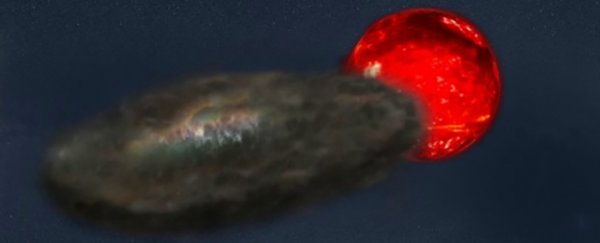You may have been lucky enough to have seen a solar eclipse in the past, but the ones we experience on Earth - where the Moon temporarily blots out all the light coming from the Sun - are nothing compared to a new stellar (star) eclipse astronomers have discovered.
Taking place once every 69 years in the binary star system TYC 2505-672-1, this particular eclipse lasts for 3.5 (Earth) years, Motherboard reports. In total, Harvard astronomer Sumin Tang and his colleagues studied more than 10,000 photographic plates captured by the American Association of Variable Star Observers (AAVSO) and the Digital Access to a Sky Century (DASCH) programs.
By also sampling data from the most recent eclipse in the system, the astronomers were able to make their calculations.
The large distance between the two stars (roughly the distance from the Sun to Uranus) accounts for the extensive 69-year period between eclipses, while the system itself is around 10,000 light-years away from Earth.
The 3.5-year eclipse period smashes the previous record held by Epsilon Aurigae - 2,200 light-years away from us - a star which sees eclipses of 640 to 730 days every 27 years. Because Epsilon Aurigae is closer and brighter, it's much easier for researchers to study.
"It's the longest duration stellar eclipse and the longest orbit for an eclipsing binary ever found… by far," said lead author Joey Rodriguez from Vanderbilt University.
"One of the great challenges in astronomy is that some of the most important phenomena occur on astronomical timescales, yet astronomers are generally limited to much shorter human timescales," his colleague Keivan Stassun added.
"Here we have a rare opportunity to study a phenomenon that plays out over many decades and provides a window into the types of environments around stars that could represent planetary building blocks at the very end of a star system's life."
The TYC 2505-672-1 system appears to consist of two giant red stars late in their life, one of which is surrounded by a huge disk of material – hence the lengthy eclipse period. While studying stars that are so far away is tricky, the team believes one of them is some 2,000 degrees Celsius hotter than our own Sun.
"Right now even our most powerful telescopes can't independently resolve the two objects," said Rodriguez. "Hopefully, technological advances will make that possible by 2080 when the next eclipse occurs."
The paper has been accepted for publication in The Astronomical Journal.
